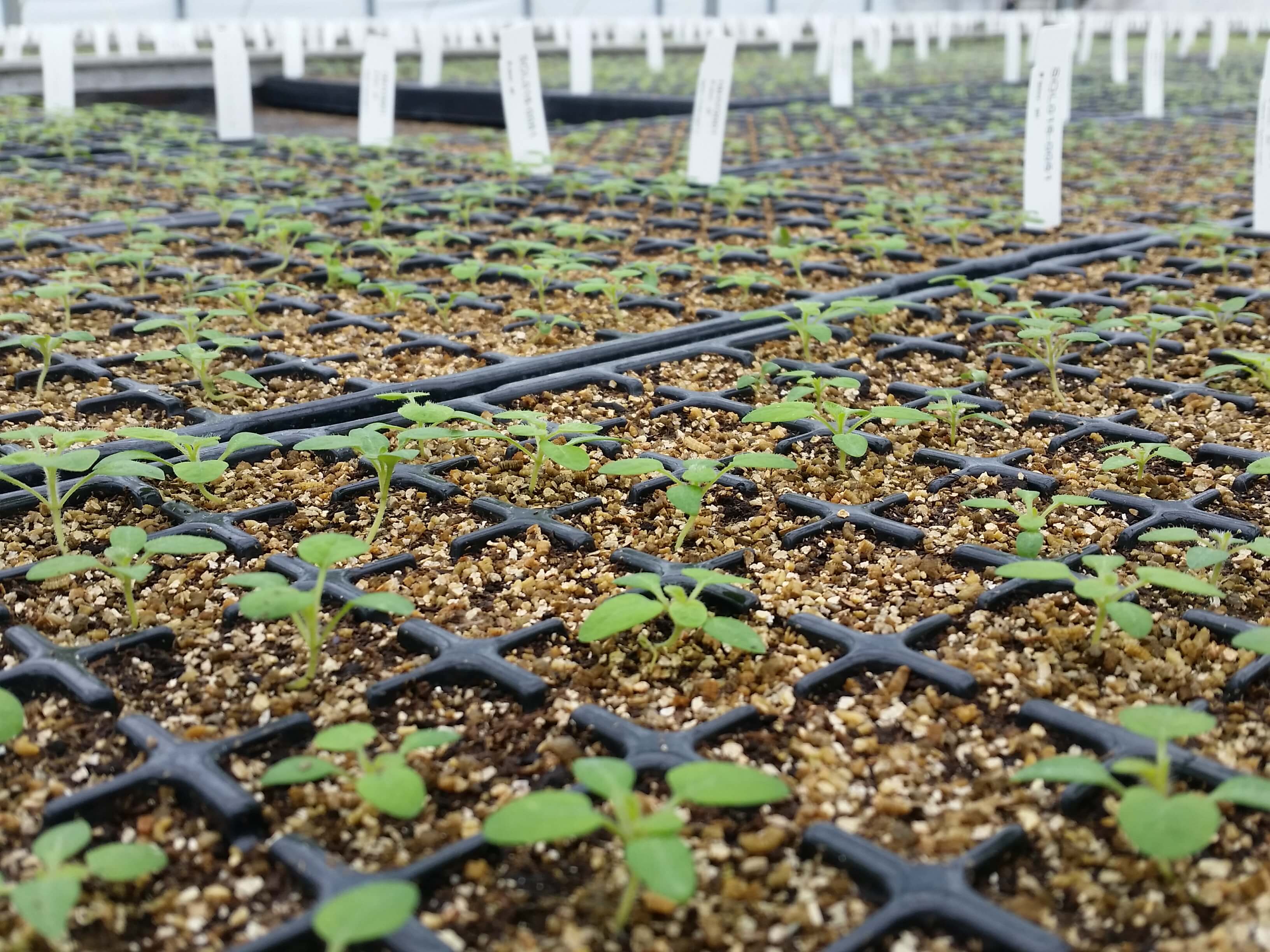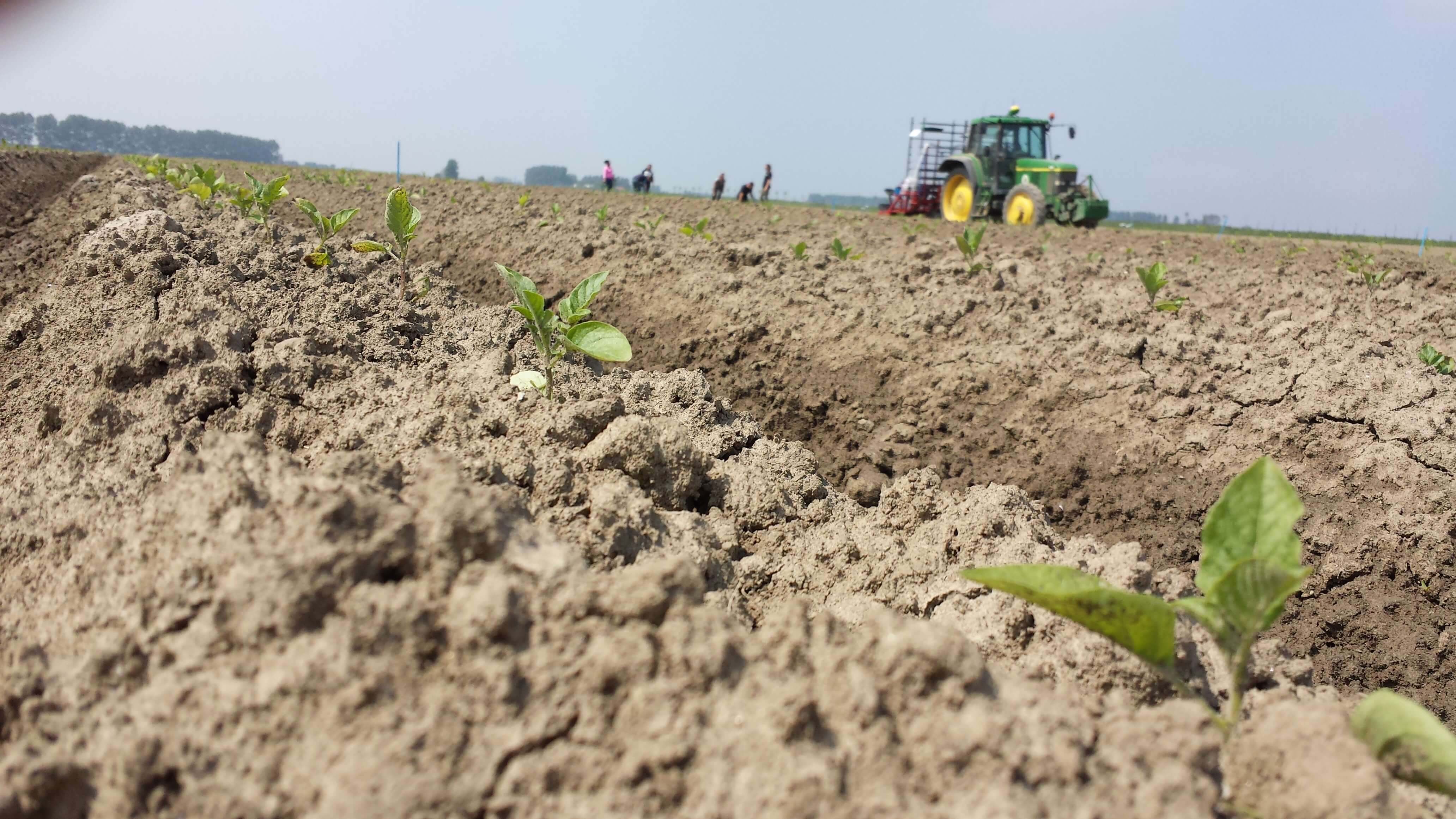This article appears in the July 2017 issue of Potato Grower.
Solynta, a Dutch potato breeding company, started the development of a hybrid potato about 10 years ago. In 2015, the first parental lines were crossed in such a way that a hybrid potato was created. In cooperation with the Royal Wilhelmina Polder Company (KMWP), the first large plot was planted in 2016.
KMWP manager Vincent Coolbergen was pleasantly surprised. “Although yield was not a goal, some of the hybrids generated the same yield as the regular varieties,” he says, a windfall neither Solynta nor KMWP had counted on at this early stage.
 The method does come with some crop management challenges, among them herbicide application and planting methods. Planting potato plantlets is a novelty that demands new crop management.
The method does come with some crop management challenges, among them herbicide application and planting methods. Planting potato plantlets is a novelty that demands new crop management.
“Once the planting is done, this crop barely differs from the regular potato crop,” Coolbergen says. “But it is the planting that provides the challenge. For this kind of hybrid plant, you need good weather. Hybrid seed potatoes are vulnerable to night frost, so you have to plant them later. Initial growth is also slower, so timing is extremely important.”
“The cultivation process is still being developed,” says Solynta agronomist Michiel de Vries. “We are seeing a lot of commonalities with other outdoor crops in terms of timing and cultivation support. Cabbage and celeriac are also first grown at a nursery and then arrive at the growers’ as seedlings. That is what we are doing with the potato plants now too.”
Naturally Crossed Resistance
For now, Solynta is primarily focused on disease-resistant potato plants. This year, the company is growing experimental hybrids with a double resistance to Phytophthora diseases (particularly late blight) for the first time, a resistance that was naturally bred into the population.
“Many growers say, ‘Just to be on the safe side, I’m still going to spray a few times [for Phytophthora,’” says de Vries. “But with resistant hybrids, they don’t need to do that. It made us a bit nervous at first, too. But they stayed healthy and green and kept growing.”
Coolbargen insists KMWP’s 4,700-acre operation is not a test farm, but that Solynta was looking for someone to bring hybrid seed potatoes from the lab into the field.
 “That makes it interesting for us, because we identify as an early adopter,” he says. “This project fits in very well with that vision.”
“That makes it interesting for us, because we identify as an early adopter,” he says. “This project fits in very well with that vision.”
Coolbergen says he understands that seed potato growers are following the developments with some hesitation.
“That makes sense, because it is about your livelihood,” he says. “Is growing from tubers going to become obsolete if this works? I don’t think that is going to happen for a while yet, and if this hybrid really takes off, it will be able to easily live side-by-side with traditionally grown seed potatoes. It is not a threat, but an opportunity … I think it is actually good that the traditional breeding method will be put under some pressure, now that the market is catching up to them with initiatives like hybrid seed potatoes.”
Social Impact
“We are looking at the social impact of this innovation,” says de Vries. “How does this change the chain, and is this a desirable change? It is not our aim to h get rid of all seed potato growers’ livelihoods. We just want to add value to the potato chain. For some of the test hybrids, the yield levels were equal to or greater than the market average achieved by regular seed potato growers in 2016.”
Crop Optimization
“In principle, hybrid seedlings as a crop are more difficult in the beginning, so the advantages are about being able to cross in disease resistances faster without diminishing the yield,” says Coolbergen. “It is really about two stories. First, you can grow potatoes from seed. I personally see that more as a development for the distant future. The second development is in the opportunities to use hybrids to cross in new traits. New trait development can be very fast. That will not be a threat, but an extra opportunity.
“When you look at other crops you can see that the revenues went up when they switched to hybrids,” Coolbergen continues. “In that sense, it is not new or complicated, but it is totally new for potatoes.”
Are these conclusions already leading to the future perspective of this new crop? The answer to that, Coolbergen believes, includes two elements. First, the industry is familiar with hybrids in other crops. If those experiences extend to potatoes, the method appears very promising. Secondly, the first year of this particular project was very successful, even though a lot of development is still required.
Costs and Benefits
Prices are not being discussed yet because, according to Coolbergen, that is not yet relevant. To gauge future prices, the competition between hybrid production and traditional seed potato growers will have to be observed. Will the cost/benefit ratio cause the introduction of hybrid seed potatoes to be delayed?
“As a farmer, I expect we will see traits in hybrid seed potatoes that we are currently looking for,” says Coolbergen. “What aspects still remain to be seen, but if you want to conquer a place on the market, you have to score with things like high costs in crop protection. If you can save on those expenses, then you already have your first profit.”
Mechanization
In terms of mechanization, there are also still some steps to be taken.
“There is not a single machine manufacturer that is doing this so far, but the market will take care of that,” says Coolbergen. “The biggest challenge for us, as the agricultural sector, is to become skilled at producing these crops. Some improvements still need to be made.”
“Particularly in terms of trait development, we still need to take some steps,” says de Vries. “We have to breed competing varieties. In addition, development of crop management strategies needs to be done to optimize the start of the crop. Our progress is promising enough that we count on bringing a full-fledged variety to the market by 2020.”
A Matter of Time
In practice, the daily issues often trump the long-term perspectives. Coolbergen warns the industry not to miss this opportunity, though. His rationale: Seed potato crops exist because commercial growers need starting material. If growers are asking for more resistant seed and hybrids can offer that, there will always be someone interested in supplying that demand.
“As a grower, you could say, ‘I’m not going to do that,’” Coolbergen says. “Farmers are generally very good at that. But if you think it will stop, one day you will no longer be a seed potato grower. If there is a demand for hybrid seed potatoes—and that time is coming—it is simply going to happen.”
This article is adapted from a story that originally appeared in the Netherlands-based publication Akkerbouwkrant.